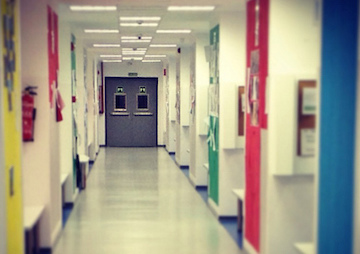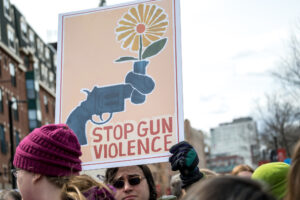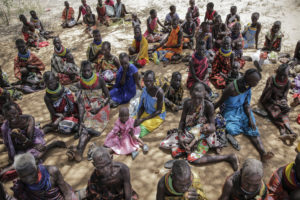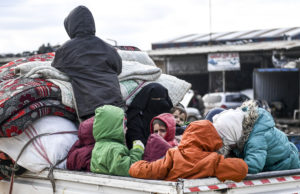Kids’ Questions on a Lockdown Planet
I just couldn’t square my son’s loving exuberance and confidence in the people around him with the sheer, teeth-hurting terror of children being stalked by an armed killer through the halls of the Friendship School. How, after all, do you practice for the unthinkable? Susana Fernandez / CC BY-ND 2.0
1
2
3
Susana Fernandez / CC BY-ND 2.0
1
2
3
“What did you do at school today, Seamus?” It’s a question I ask him everyday.
“Well,” my proud preschooler begins, “we did not have a lockdown drill today.” And that’s about as far as he gets in the art of storytelling. Sometimes I’ll get something about “bim” (gym) or how “Bambi” (Jeremy) pinched him during free play. But the thing that preoccupies my precocious three year old every single day he goes to school is the lockdown drill he and his classmates had in their first month of school.
At a parent-teacher conference in November, my husband Patrick and I got a fuller picture of this episode from his teacher. When the lockdown began, she says, Seamus and his classmates were in the hall on their way to the library. Amid the clangs, they sought refuge in the gymnasium closet. Eighteen kids and two teachers sitting crisscross applesauce on its floor amid racks of balls and hula hoops. Seamus, she tells us, sat on her lap with his fingers in his mouth and cried the entire time.
“Does he talk about it at home?” she asks.
“It’s as though nothing else happens at school,” my husband replies. “He talks about lockdown drills all the time.”
She informs us that the drills happen about once a month, and that Seamus remains easily startled long after they’re over, running for shelter between an adult’s legs whenever he hears loud noises in the classroom.
At that moment — not exactly one of my proudest — I burst into tears. I just couldn’t square my son’s loving exuberance and confidence in the people around him with the sheer, teeth-hurting terror of children being stalked by an armed killer through the halls of The Friendship School. How, after all, do you practice for the unthinkable? This is a subject that’s been on my mind since I was hardly older than he is now. I look over at him playing contently with his sisters, Madeline, almost two, and Rosena, almost nine, so proud to share his classroom with them.
“At home,” I tell the teacher through my tears, “we chant ‘Gun Control, Not Lockdown Drills!’ whenever he talks about them.” And then I add, “It makes me so angry that he and his friends have to go through this trauma and the big men get to keep their right to bear assault weapons. He should be scared of lockdown drills. They sound terrible. He shouldn’t have to practice surviving a mass killing episode at one of his favorite places in the whole wide world.” I wipe my tears away, but they just keep coming.
Our kids ask us all sorts of questions. Why? Why? Why? They are tiny existentialists. Why is the sky blue? Why do people die? Why does grass grow? They regularly demand that we explain the world to them. Good luck!
His teacher is so earnest and so young and I feel so brittle and so extreme as I cry, folded into one of the small seats at a quarter-sized table in her cheerful classroom. “I am sorry,” I finally say.
“No, no, its okay,” she replies with all the kind politeness a teacher learns. “It is hard,” she continues, “but this is real. We have to practice for this kind of thing.”
Thinking the Unthinkable
I wonder, of course. I know that so much of this is based on fears — not quite irrational but blown out of all proportion — that have been woven into our American world. My husband reminds me of how his parents’ generation had to practice surviving a nuclear attack by doing “duck and cover” drills under their desks. I was too young to duck and cover, but my parents were ardent anti-nuclear activists with no inhibitions about describing to a child just what such a war would mean so I learned to be terrified of nuclear war at a very young age.
I came to believe that the only thing keeping Soviet and American intercontinental ballistic missiles from decimating our cities was the activism, organizing, and witness of my parents and their small band of friends and fellow travelers. We would stand in front of the Pentagon — this was in the late 1970s and throughout the 1980s — holding up signs with slogans like “You can’t hide from a nuclear bomb” and the old symbol for a fallout shelter printed below it. I was taught that there could be no security, no safety in a world full of nuclear weapons, that the only way to be safe was to get rid of them.
Imagine how I feel all these years later in a world still chock-a-block full of such weapons. These days, I wonder why the fear of them has disappeared, while the weaponry remains. Is that better or worse for Seamus’s generation? And what about our present set of fears? What about our twenty-first-century whys?
Assuming there are more Adam Lanzas out there (and there obviously are), that more gun shops will sell ever more implements of rapid-fire death and destruction, and that more gun lobbyists and promoters will continue to cling to this “God-given, constitutionally enshrined right,” my son does need to endure more lockdown drills.
The consensus of school security experts is certainly that the massacre at Sandy Hook Elementary School in Newtown, Connecticut (only 80 miles from our house), would have been much worse if the students and teachers hadn’t been practicing for exactly the nightmare scenario that struck on December 14, 2012.
But how can I explain any of this to my little boy when it makes no sense to me? When it makes no sense, period?
Your support matters…Independent journalism is under threat and overshadowed by heavily funded mainstream media.
You can help level the playing field. Become a member.
Your tax-deductible contribution keeps us digging beneath the headlines to give you thought-provoking, investigative reporting and analysis that unearths what's really happening- without compromise.
Give today to support our courageous, independent journalists.







You need to be a supporter to comment.
There are currently no responses to this article.
Be the first to respond.